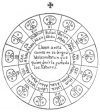
Sacred Texts Native American Maya Index Previous Next
Buy this Book at Amazon.com

Yucatan Before and After the Conquest, by Diego de Landa, tr. William Gates, [1937], at sacred-texts.com
Not only did the Indians have a count for the year and months, as has been before set out, but they also had a certain method of counting time and their matters by ages, which they counted by 20-year periods, counting thirteen twenties, with one of the twenty signs in their months, which they call Ahau, not in order, but going backwards as appears in the following circular design. In their language they
 Click to enlarge |
As to who it was that arranged this count of katuns, if it was the evil one it was so done as to serve in his honor; if it was a man, he must have been a great idolater, for to these katuns he added all the deceptions, auguries and impostures by which these people walked in their misery, completely blinded in error. Thus this was the science to which they gave most credit, held in highest regard, and of which
not even all the priests knew the whole. The way they had for counting their affairs by this count, was that they had in the temple two idols dedicated to two of these characters. To the first, beginning the count with the cross above the circular design, they offered worship, with services and sacrifices to secure freedom from ills during the twenty years; but after ten years of the first twenty had passed, they did no more than burn incense and do it reverence. When the twenty years of the first had passed, they began to follow the fates of the second, making their sacrifices; and then having taken away that first idol, they set up another for veneration during the next ten years.
Verbi gratia. The Indians say that the Spaniards finally reached the city of Merida in the year of Our Lord's birth 1541, which was exactly at the first year of the era of Buluc (11) Ahau, which is in that block where the cross stands; also that they arrived in the month Pop’, which is the first month of their year. If the Spaniards had not arrived, they would have worshipped the image of Buluc Ahau until the year ’51, that is for ten years, and then would have set up another idol for Bolon (9) Ahau up to the year ’61, when they would remove it from the temple and replace it with the idol for Vuc Ahau, then following the predictions of Bolon Ahau for another ten years, thus doing with all in their turn. Thus they venerated each katun for twenty years, and during ten years they governed themselves by their superstitions and deceits, all of which were so many and such as to hold in error these simple people, that one would have to marvel over it who did not know the things of Nature and the experience the devil possesses in dealing with them.
These people also used certain characters or letters, with which they wrote in their books about the antiquities and their sciences; with these, and with figures, and certain signs in the figures, they understood their matters, made them known, and taught them. We found a great number of books in these letters, and since they contained nothing but superstitions and falsehoods of the devil we burned them all, which they took most grievously, and which gave them great pain.
Of their letters we give here an a, b, c, their cumbersomeness not permitting more, because for all the aspirations of the letters they use one character, and then for uniting the parts another, going on in this way ad infinitum, as in the following example. Le means a lasso, and to hunt with one; to write it with their letters, they wrote them with three, at the aspiration of the l the vowel e, put before it; in this they are not at fault, although they use the e if they wish to do so for definiteness. Example: e l e lé; afterwards they put the syllable joined:

Há means water; because the sound of the letter aitch is composed of a, h, before it, they put it at the beginning with a, and a ha at the end in this fashion:
 |
They also wrote in syllables, but in one and the other style: I only put it here in order to give a complete account of the matters of this people. Ma in kati means 'I do not wish,' and they write it in syllables in this manner:
 Here begins their a, b, c:
Here begins their a, b, c:
The letters that do not appear are wanting in this language; and they have others in addition to ours, for other things where they are needed. But they no longer use any of the characters, especially the young people who have learned ours.
81:* The center of the wheel reads: They call this count in their language vazlazon katun, which means the 'revolution of the katuns.'